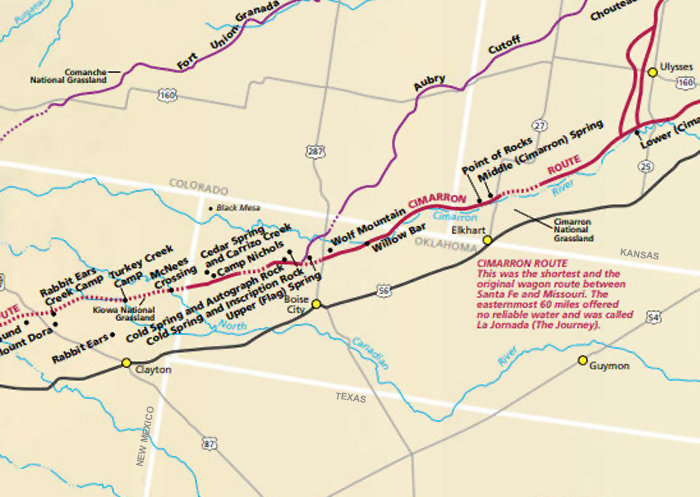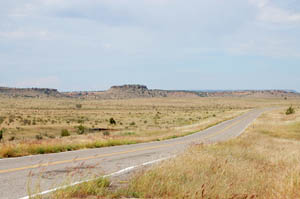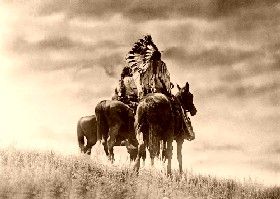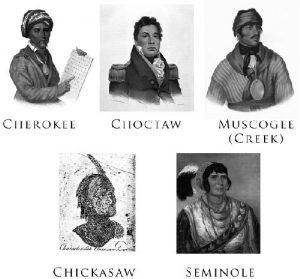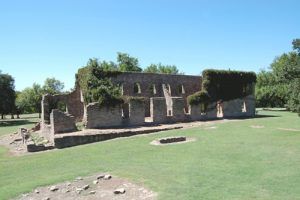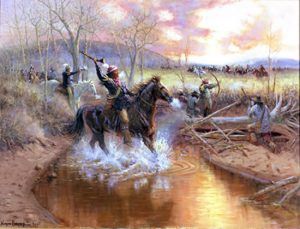The Santa Fe Trail in Oklahoma – Legends of America (original) (raw)
Oklahoma Santa Fe Trail Route
“There was the desert mirage, a will-o’-the wisp that beckoned and taunted. Sometimes it would look like a party of mounted Indians, and the women would cry and begin counting their children.”
— Marion Russell, on the Cimarron Cutoff, 1852
Of the five states along the Santa Fe Trail, Oklahoma’s growth and development were the least affected by the historical trade route. However, Oklahoma played an important role in sustaining travelers along the Cimarron Route – after their encounter with the 60-mile La Jornada – by providing abundant water and campsites.
Cimarron County, Oklahoma, by Kathy Alexander.
The smallest portion of the Santa Fe Trail was in Oklahoma. Of the two major trail branches, only the Cimarron Route crossed into the state through the western portion of the Oklahoma panhandle in modern Cimarron County. The Cimarron Route within Oklahoma was only 46 miles long from the northern border with Colorado southwest to the border with New Mexico. The lesser-used Aubry Cutoff was also partially within Oklahoma. This route started near Fort Aubrey in western Kansas, crossed the Arkansas River at the crossing downstream from the fort, forded the Cimarron River in northern Cimarron County, Oklahoma, and ended near Cold Spring Campground, northwest of modern Boise City.
Early Ownership and Occupation of Oklahoma
When trade between Missouri and Santa Fe began in 1821, the lands now comprising the State of Oklahoma were not a state. Like Missouri and Kansas, England, France, and Spain had each claimed these lands at various times. When France recognized Spain as the owner of the Province of Louisiana at the end of the Seven Years’ War, this land came under Spanish jurisdiction. From 1763 to 1800, Spain maintained ownership, but with the Treaty of San Ildefonso in 1800, the title was transferred to Napoleonic France, and by 1804, the U.S. owned this portion of North America.
However, when acquired from France, the boundaries of the Louisiana Territory were not well defined. This was particularly true of the boundary with Spain’s New World territories, including the Oklahoma panhandle. As part of the 1819 Florida Purchase (or Adams-Onís Treaty), US Secretary of State John Quincy Adams and Spanish diplomat Luis de Onís established the boundary between the United States and Spain as the right (west) bank of the Sabine River, the right (south) bank of the Red River, the 100th meridian, the right (south) bank of the Arkansas River, a line from the headwaters of the Arkansas River to the 42nd parallel, and then west on this parallel to the Pacific Ocean. As the Red River and 100th meridian now form parts of Oklahoma’s south and western boundaries, this placed all but the panhandle within the United States.
Indian Country
Cheyenne Warriors by Edward S. Curtis
Before the emigration of eastern tribes, at least four indigenous tribes were located in Oklahoma, including the Wichita, Arapaho, Cheyenne, and Comanche. The Wichita were located in northern Oklahoma, and the Comanche lands were in the short grass plains in the general vicinity where Kansas, Oklahoma, Colorado, and New Mexico come together. The Cheyenne and Arapaho were located on the High Plains west edge in western Kansas, eastern Colorado, and western Oklahoma.
From 1803 until 1830, the U.S. portion of Oklahoma remained part of the Indian country. In this unorganized region, eastern Indian tribes were removed as white settlers encroached upon tribal lands. The same year the US government purchased Louisiana, President Thomas Jefferson considered exchanging land in the west for tribal lands in the east. Some Indian factions and tribes viewed ceding their land as a way to maintain their culture without continual pressure from whites, but others objected, causing tribal rifts. Voluntary removal of consenting tribes occurred in the first decades of the 19th century, with the Five Civilized Tribes arriving in Arkansas by 1817. When Missouri petitioned for statehood in 1819, Congress established Arkansas Territory, which included the present state of Arkansas and the part of Oklahoma east of the 100th meridian. In 1820, most of what would become the state of Oklahoma “was divided among the Five Civilized Tribes.”
Before 1825 the boundary between Indian lands and white settlement areas included a strip of present-day eastern Oklahoma. Two forts near this border were established to replace Fort Smith, Arkansas, in guarding traders and travelers against Indian attacks along the Indian frontier. The more northern of these was Fort Gibson, located at the forks of the Arkansas, Verdigris, and Grand Rivers. To the south was Fort Towson, which was situated near the mouth of the Kiamichi River. In 1825, due to objections from the Cherokee and Choctaw about the encroachment of white settlers, a new treaty was negotiated to adjust the western boundary of Arkansas Territory to the current Arkansas-Oklahoma state line and remove settlers to the area east of the border. Under this Treaty with the Choctaw, 1825, the western half of Arkansas Territory remained officially unorganized Indian Territory, as created under the 1834 renewal of the Indian Trade and Intercourse Act. The only Euro-Americans legally residing within the Indian Territory were Indian agents, missionaries, military personnel, and a few whites who had married into tribes. Despite that ban, Euro-American settlers, primarily from Texas and southern states, entered this area illegally in the 1820s-1830s. The panhandle remained part of Spain until Mexican independence in 1821, when it came under Mexican authority.
The Five Civilized Tribes courtesy Wikipedia.
Indian resettlement within Oklahoma mostly involved the southeastern Indian nations (Cherokee, Choctaw, Chickasaw, Muscogee [Creek], and Seminole) known together as the Five Civilized Tribes. With the election of President Andrew Jackson in 1828, the issue of Indian removal reached a climax. On May 28, 1830, Congress passed the Indian Removal Act. This act embodied President Andrew Jackson’s Indian policy, calling for the voluntary removal of Indian tribes from the eastern US. By the end of the 1830s, however, this policy shifted from voluntary to the forced cession of Indian lands in the East to the United States and the emigration of eastern tribes to reservations west of the boundaries of Missouri and Arkansas. The precedent for this policy change came as eastern Cherokee, objecting to the move that had been agreed to by a faction of the tribe in the 1835 Treaty of New Echota, refused to voluntarily leave their lands, fields, homes, and towns in Georgia.
During the spring of 1838, Major General Winfield Scott was dispatched by the War Department to remove the Cherokee forcefully. In what became known as the Trail of Tears, more than 1000 Cherokee eventually died en route from the heat, unfamiliar diet, unsanitary conditions, and grief over the move. The other four tribes had been forced to remove from the lands in the southeastern US before the Cherokee, although smaller groups of Seminole arrived in Oklahoma by 1842.
After the Civil War and into the 1880s, additional Indian tribes were removed to the Indian Territory. These included indigenous tribes from the west and north and tribes that had previously been removed to Kansas. Among these tribes were the: Delaware, Sac and Fox, Potawatomi, Shawnee, Peoria, Otoe, Missouria, Kickapoo, Iowa, Ottawa, Miami, Illinois, Mohawk, Kaskaskia, Chippewa, Cayuga, Seneca, Piankashaw, Wea, Tuscarora, Wyandot, Quapaw, Ponca, Kanza, Pawnee, Arapaho, Cheyenne, Comanche, Kiowa, Kiowa-Apache, and Wichita. Forts Sill, Reno, and Supply were established in the western portion of Indian Territory to discourage Indian attacks, especially by the Kiowa, Comanche, Cheyenne, and Arapaho.
Fort Washita East barracks
The Oklahoma panhandle land became part of the Republic of Texas in 1836 due to the defeat of Santa Anna’s army at the Battle of San Jacinto and Texas’ independence from Mexico. In 1842 Fort Washita was established on the Washita River about 15 miles north of the Canadian River – the Texas border. President James Polk signed a proclamation on December 29, 1845, making Texas a state. It was not until the Compromise of 1850 that Texas relinquished the Oklahoma panhandle to the United States, and Texas’s present boundaries were set. Due to the late acquisition of the Panhandle by the United States, it was not a part of any state or territory.
Increasing numbers of white settlers entered Indian Territory after the Civil War. Many worked on railroads, in mining, in the cattle trade, and as agricultural tenants on Indian lands. White ownership of land in what became Oklahoma was not permitted until 1889. At this time, white settlement was limited to the “Unassigned Lands” in the future state’s central portion. White settlers in significant numbers did not arrive in central and western portions of Indian Territory or in the panhandle (known as No Man’s Land) until the last decade of the nineteenth century. The Organic Act of May 2, 1890, created Oklahoma Territory from the Unassigned Lands, the area west of the Five Civilized Tribes that were not assigned to any tribe, and from No Man’s Land. Additional lands were added as Indian lands were surveyed and made available under the 1887 Dawes Act and the Curtis Act of 1898, which broke up reservations, gave the individual title to up to 160 acres for each Indian, then allowed remaining “surplus” lands to be sold to non-Indians. The Oklahoma land rushes between 1889 and 1905 opened surplus Indian land from the old Indian Territory to the east and unorganized land in Oklahoma Territory to homesteaders, disposing of millions of acres. The Oklahoma Enabling Act, signed June 16, 1906, allowed for the formation of the new state of Oklahoma, though the question of what to include within the new state was debated. There was strong support, especially among the Five Civilized Tribes, for two separate states – Oklahoma (a non-Indian state) and Sequoyah (an Indian state). However, on November 16, 1907, during the administration of President Theodore Roosevelt, Oklahoma Territory, and Indian Territory were joined, and Oklahoma became the 46th state, subsequently dissolving Indian Territory.
The Civil War and the Santa Fe Trail in Oklahoma
Civil War in Oklahoma
During the Civil War, Union forces withdrew into Kansas Territory, leaving Indian Territory to the Confederacy. Some factions within the Five Tribes, led by John Ross of the Cherokee and Opothle Yahoa of the Creek, argued for neutrality during the war. Except for the Choctaw, the Five Tribes did not unanimously agree to side with the Confederacy at first; however, with the removal of Union forces – and federal allotment monies – an alliance was sought. After the Union’s removal, the decision to side with the Confederates was driven by negotiations and treaties made with the Five Tribes by Albert Pike, a Confederate. In his negotiations, he promised that each tribe would hold title to the lands that they lived on. Confederate President Jefferson Davis had other ideas. He stated clearly in a report that the lands owned by the Five Tribes would be “turned into a state.” The deception was the driving force behind the joining and the controversy over aligning with the Confederacy; thousands of individuals from the Five Tribes joined the war effort, divided between the opposing forces. No major Civil War battles were fought in Oklahoma, but there was heavy fighting in several skirmishes, mostly in the eastern quarter of the future state. During the war, Union and Confederate forces and guerilla bands plundered the tribal fields, orchards, and livestock and burned homes, schools, and churches. By the end of the conflict, much of the area was devastated. The tribes’ alliance with the Confederacy was used against them as the rationale for annulling and abrogating earlier treaty agreements. Eventually, in 1866, Congress decided to authorize the cancellation of all existing treaties with the Five Tribes. They were forced to cede large portions of their lands in Indian Territory to immigrant tribes being expelled from Kansas.
Established just after the Civil War, Camp Nichols was the only military post along the Oklahoma portion of the Santa Fe Trail. In May 1865, General James H. Carleton, commander of the Department of New Mexico, ordered Colonel Christopher “Kit” Carson to establish a halfway post between the Cimarron Crossing of the Arkansas River and Fort Union in New Mexico. Founded as the western terminus of the Aubry Route, this new post intended to protect wagon trains traveling along the Cimarron and Aubry routes from Indian raids. The small fortified post was located on high ground between two forks of South Carrizozo Creek, about one-half mile north of the Santa Fe Trail and a short distance east of Cedar Spring. The post was constructed and manned by three companies of New Mexico and California volunteers who escorted wagon trains along the trail and protected traffic primarily from raids by Kiowa, Comanche, Cheyenne, and Arapaho. Lieutenant Richard Russell and his wife Marion arrived at the post in June 1865, about two weeks after construction began. Marion noted that the soldiers built several stone-walled dugouts with dirt floors and dirt roofs supported by logs. The stone walls of the dugouts formed an enclosure, outside of which was a moat. These structures housed the seven officers and had other functions, such as a hospital. Some 300 soldiers lived in tents and dugouts within the enclosure. There were also ten Indian scouts, two Indian women, and two laundresses who were wives of Hispanic soldiers at the post. Wagon trains outbound from New Mexico assembled at this post about 130 miles east of Fort Union. From here, they were escorted by detachments of troops to the Arkansas River. Camp Nichols was only occupied for a few months before being abandoned in late September by the Army when raids by Indians decreased.
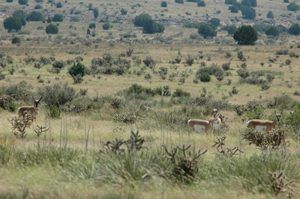
Antelope in the Oklahoma Panhandle
Although the Santa Fe Trail crossed Cimarron County in the Oklahoma panhandle, it had little impact on trade and development of Indian Territory, Oklahoma Territory, or the future county or state. The Missouri to Santa Fe route was less significant to Oklahoma than to the other states it crossed. The less well-known route used by Josiah Gregg’s livestock traders, which ran across Oklahoma from Van Buren, Arkansas, into New Mexico, generally following the Canadian River, had a greater impact on this state than did the Cimarron Route. No towns were laid out along the Santa Fe Trail in Oklahoma while the route was active. The unincorporated town of Wheeless, the only populated place in the general trail corridor, was not settled until 1907 and was a few miles south of the trail – about three miles from Camp Nichols. The only manmade structures built during the 59-year Santa Fe Trail period were Camp Nichols and Cold Spring stage station, both semi-permanent and short duration. A branch of the Atchison, Topeka & Santa Fe Railroad was built across Cimarron County; however, it did not follow the trail’s route. No roads or highways follow the trail route through the Oklahoma panhandle. Some individuals from the Indian Nations were likely employed by trail freighters as teamsters or drovers. Some who worked or traveled along the trail may have subsequently settled in Oklahoma.
Autograph Rock, Santa Fe Trail, Oklahoma by the National Park Service.
Compiled & edited by Kathy Alexander/Legends of America, updated April 2023.
Also See:
Santa Fe Trail Detail & Timeline
Source: Santa Fe Trail National Register of Historic Places Nomination
